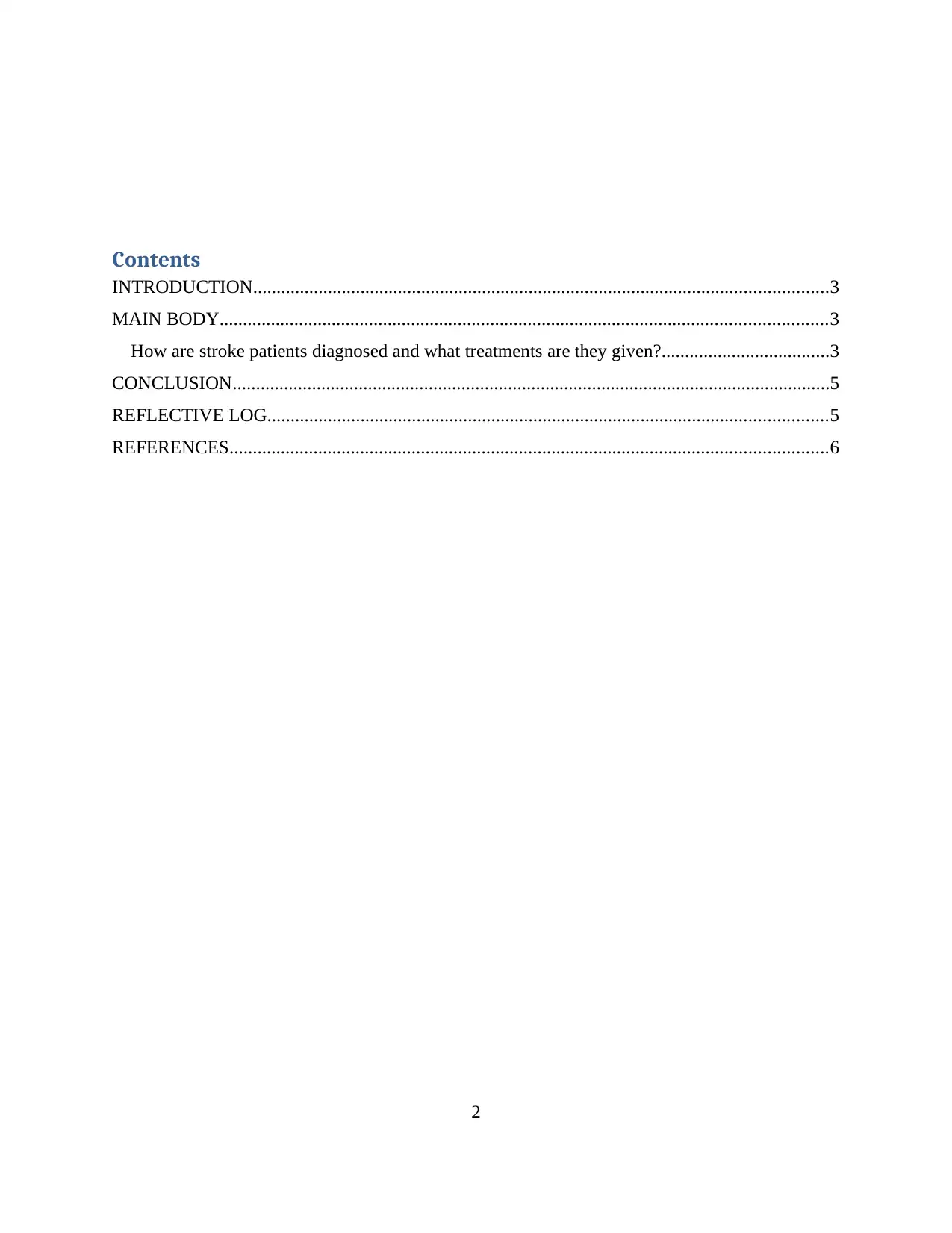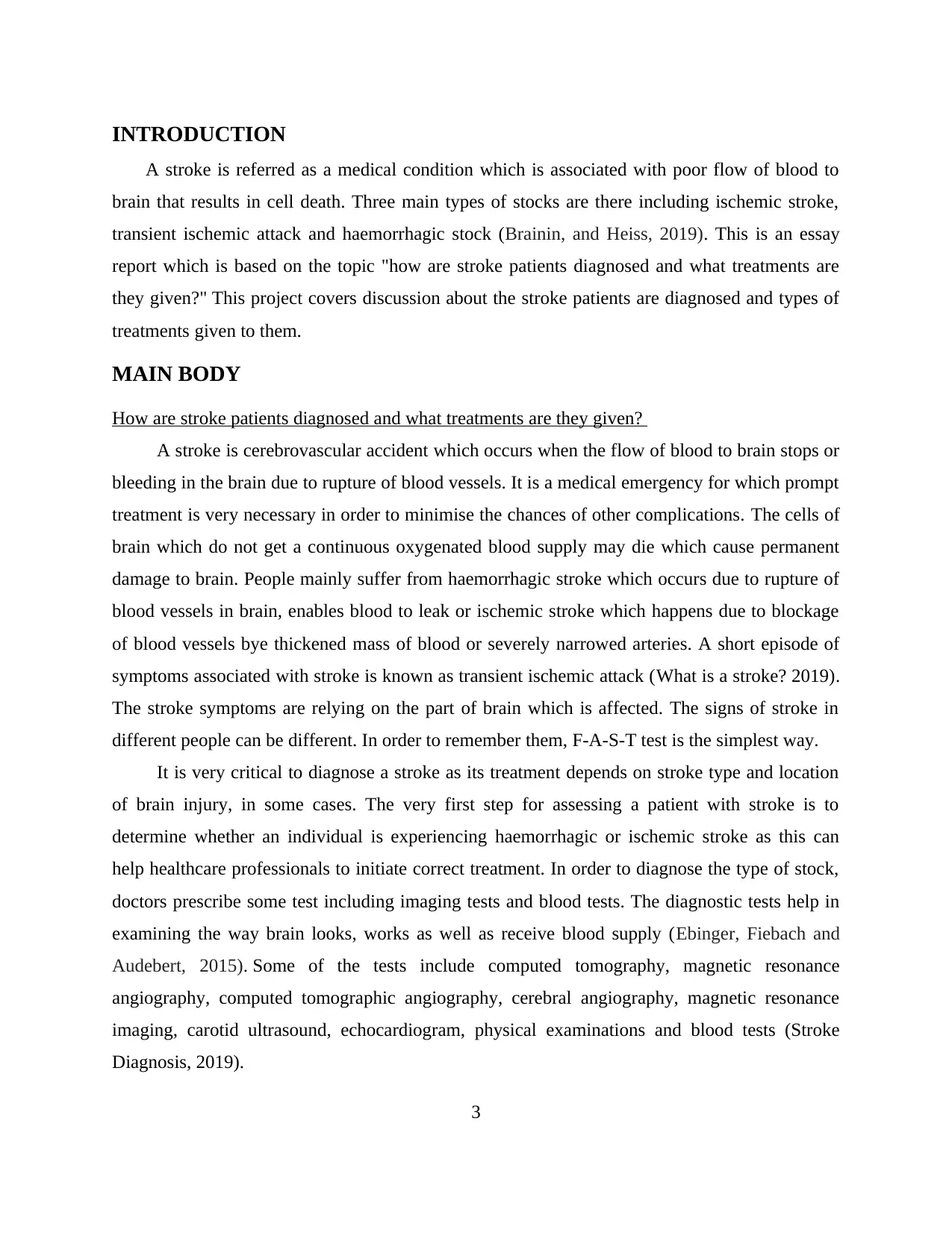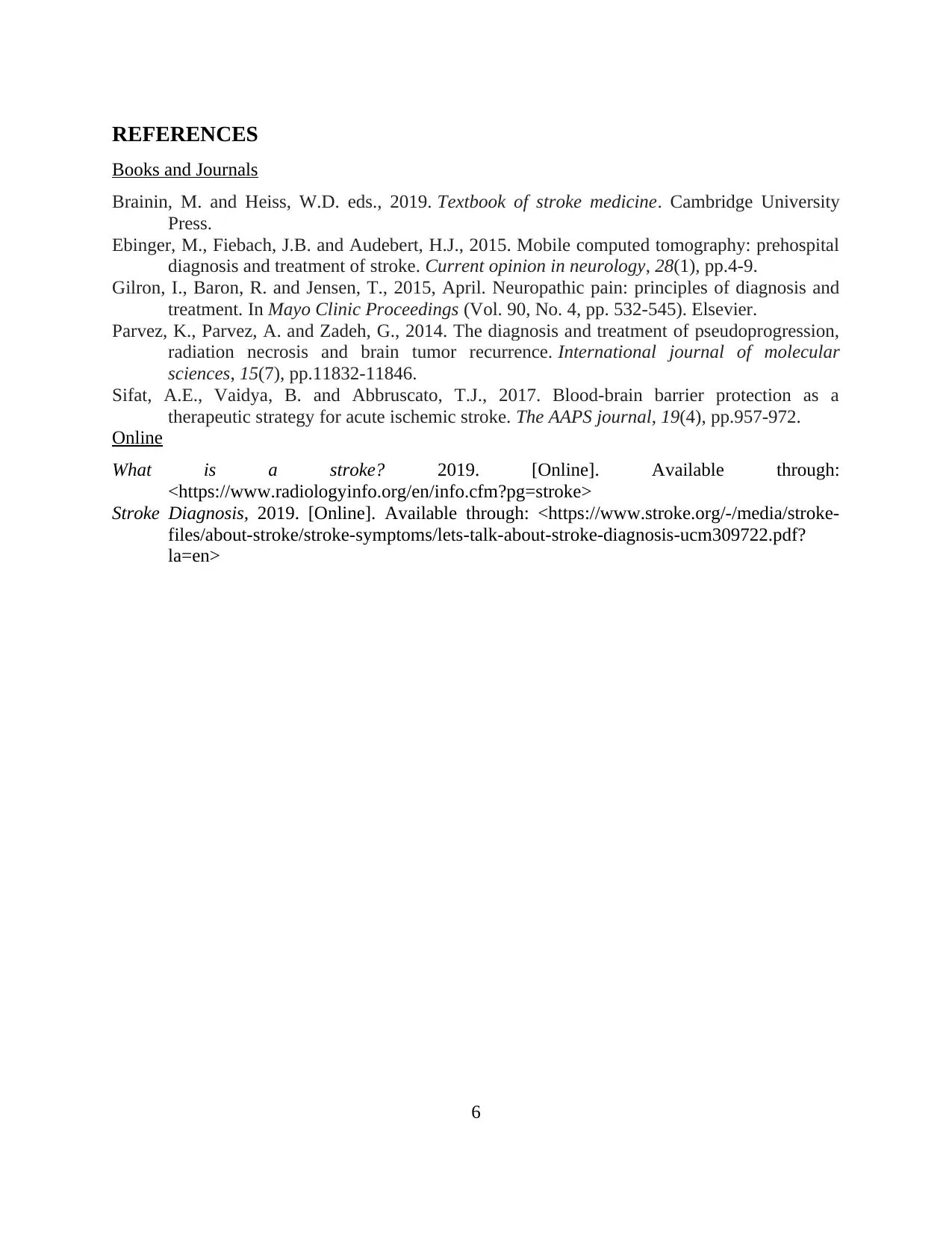How are stroke patients diagnosed and what treatments are they given?
VerifiedAdded on 2023/01/11
|6
|1418
|21
AI Summary
This essay report discusses the diagnosis and treatment of stroke patients. It covers the different types of strokes, diagnostic tests such as computed tomography and magnetic resonance imaging, and treatment options including medication and surgery.
Contribute Materials
Your contribution can guide someone’s learning journey. Share your
documents today.

Producing An Essay
1
1
Secure Best Marks with AI Grader
Need help grading? Try our AI Grader for instant feedback on your assignments.

Contents
INTRODUCTION...........................................................................................................................3
MAIN BODY..................................................................................................................................3
How are stroke patients diagnosed and what treatments are they given?....................................3
CONCLUSION................................................................................................................................5
REFLECTIVE LOG........................................................................................................................5
REFERENCES................................................................................................................................6
2
INTRODUCTION...........................................................................................................................3
MAIN BODY..................................................................................................................................3
How are stroke patients diagnosed and what treatments are they given?....................................3
CONCLUSION................................................................................................................................5
REFLECTIVE LOG........................................................................................................................5
REFERENCES................................................................................................................................6
2

INTRODUCTION
A stroke is referred as a medical condition which is associated with poor flow of blood to
brain that results in cell death. Three main types of stocks are there including ischemic stroke,
transient ischemic attack and haemorrhagic stock (Brainin, and Heiss, 2019). This is an essay
report which is based on the topic "how are stroke patients diagnosed and what treatments are
they given?" This project covers discussion about the stroke patients are diagnosed and types of
treatments given to them.
MAIN BODY
How are stroke patients diagnosed and what treatments are they given?
A stroke is cerebrovascular accident which occurs when the flow of blood to brain stops or
bleeding in the brain due to rupture of blood vessels. It is a medical emergency for which prompt
treatment is very necessary in order to minimise the chances of other complications. The cells of
brain which do not get a continuous oxygenated blood supply may die which cause permanent
damage to brain. People mainly suffer from haemorrhagic stroke which occurs due to rupture of
blood vessels in brain, enables blood to leak or ischemic stroke which happens due to blockage
of blood vessels bye thickened mass of blood or severely narrowed arteries. A short episode of
symptoms associated with stroke is known as transient ischemic attack (What is a stroke? 2019).
The stroke symptoms are relying on the part of brain which is affected. The signs of stroke in
different people can be different. In order to remember them, F-A-S-T test is the simplest way.
It is very critical to diagnose a stroke as its treatment depends on stroke type and location
of brain injury, in some cases. The very first step for assessing a patient with stroke is to
determine whether an individual is experiencing haemorrhagic or ischemic stroke as this can
help healthcare professionals to initiate correct treatment. In order to diagnose the type of stock,
doctors prescribe some test including imaging tests and blood tests. The diagnostic tests help in
examining the way brain looks, works as well as receive blood supply (Ebinger, Fiebach and
Audebert, 2015). Some of the tests include computed tomography, magnetic resonance
angiography, computed tomographic angiography, cerebral angiography, magnetic resonance
imaging, carotid ultrasound, echocardiogram, physical examinations and blood tests (Stroke
Diagnosis, 2019).
3
A stroke is referred as a medical condition which is associated with poor flow of blood to
brain that results in cell death. Three main types of stocks are there including ischemic stroke,
transient ischemic attack and haemorrhagic stock (Brainin, and Heiss, 2019). This is an essay
report which is based on the topic "how are stroke patients diagnosed and what treatments are
they given?" This project covers discussion about the stroke patients are diagnosed and types of
treatments given to them.
MAIN BODY
How are stroke patients diagnosed and what treatments are they given?
A stroke is cerebrovascular accident which occurs when the flow of blood to brain stops or
bleeding in the brain due to rupture of blood vessels. It is a medical emergency for which prompt
treatment is very necessary in order to minimise the chances of other complications. The cells of
brain which do not get a continuous oxygenated blood supply may die which cause permanent
damage to brain. People mainly suffer from haemorrhagic stroke which occurs due to rupture of
blood vessels in brain, enables blood to leak or ischemic stroke which happens due to blockage
of blood vessels bye thickened mass of blood or severely narrowed arteries. A short episode of
symptoms associated with stroke is known as transient ischemic attack (What is a stroke? 2019).
The stroke symptoms are relying on the part of brain which is affected. The signs of stroke in
different people can be different. In order to remember them, F-A-S-T test is the simplest way.
It is very critical to diagnose a stroke as its treatment depends on stroke type and location
of brain injury, in some cases. The very first step for assessing a patient with stroke is to
determine whether an individual is experiencing haemorrhagic or ischemic stroke as this can
help healthcare professionals to initiate correct treatment. In order to diagnose the type of stock,
doctors prescribe some test including imaging tests and blood tests. The diagnostic tests help in
examining the way brain looks, works as well as receive blood supply (Ebinger, Fiebach and
Audebert, 2015). Some of the tests include computed tomography, magnetic resonance
angiography, computed tomographic angiography, cerebral angiography, magnetic resonance
imaging, carotid ultrasound, echocardiogram, physical examinations and blood tests (Stroke
Diagnosis, 2019).
3

In computed tomography scan, a picture of brain is creating by using radiation. This is the
first test which is given to the patient who has stroke symptoms. The result of computed
tomography test provides valuable information regarding the cause of stroke along with the
location and the degree to which brain is injured (Gilron, Baron, and Jensen, 2015). This helps in
detecting weather the stroke is from bleeding or blood clot. The physical examination includes
that general tests that doctors perform like checking blood pressure, listening heartbeat etc. The
doctors also perform neurological exam in order to see the way stroke is affecting nervous
system.
In magnetic resonance imaging, a large magnetic field is used to produce brain image
similar as the CT scan. The image created by magnetic resonance imaging is sharper as well as
more detailed in comparison to computed tomography scan so, for diagnosing small and deep
injuries, this test is often prescribed by doctors. The another method of diagnosing stroke is
computed tomographic angiography in which dye is injected in a vein and pictures of blood
vessels are taken to look for abnormalities like aneurysm. This test provides a detailed image of
arteries in neck and brain.
Immediate treatment of stroke can reduce disability and save lives. Its treatment relies on
type of stroke and its severity. If the stroke happens due to blood clot, then a clot busting drug
help in restoring the flow of blood to damaged area brain. Patients also get blood thinning drugs
in hospitals including warfarin or aspirin. The other treatment of stocks include surgery by which
the damage vessels of blood are repair and the blood is removed from around the brain (Sifat,
Vaidya and Abbruscato, 2017). For treating the ischemic stroke, emergency IV medication is
given to patient. The drug therapy helps in break up the clot and improving the chances of
survival by reducing complications. The IV injection of tissue plasminogen activator is the
standard treatment of ischemic stroke. it helps in restoring the flow of blood by dissolving clot.
The another treatment is angioplasty in which a catheter is infused to carotid arteries by an
artery in groin. Then, a balloon is inflated to expand the artery which is narrowed and then a
stent is inserted in order to support the open artery. The treatment of hemorrhagic stroke
emphasizes on reducing pressure in brain caused due to excess fluid and controlling the bleeding.
A surgery is performed by doctors if the bleeding area is large for removing blood and relieving
pressure on brain. It is also performed to repair issues of blood vessels related to hemorrhagic
stroke (Parvez, Parvez and Zadeh, 2014).
4
first test which is given to the patient who has stroke symptoms. The result of computed
tomography test provides valuable information regarding the cause of stroke along with the
location and the degree to which brain is injured (Gilron, Baron, and Jensen, 2015). This helps in
detecting weather the stroke is from bleeding or blood clot. The physical examination includes
that general tests that doctors perform like checking blood pressure, listening heartbeat etc. The
doctors also perform neurological exam in order to see the way stroke is affecting nervous
system.
In magnetic resonance imaging, a large magnetic field is used to produce brain image
similar as the CT scan. The image created by magnetic resonance imaging is sharper as well as
more detailed in comparison to computed tomography scan so, for diagnosing small and deep
injuries, this test is often prescribed by doctors. The another method of diagnosing stroke is
computed tomographic angiography in which dye is injected in a vein and pictures of blood
vessels are taken to look for abnormalities like aneurysm. This test provides a detailed image of
arteries in neck and brain.
Immediate treatment of stroke can reduce disability and save lives. Its treatment relies on
type of stroke and its severity. If the stroke happens due to blood clot, then a clot busting drug
help in restoring the flow of blood to damaged area brain. Patients also get blood thinning drugs
in hospitals including warfarin or aspirin. The other treatment of stocks include surgery by which
the damage vessels of blood are repair and the blood is removed from around the brain (Sifat,
Vaidya and Abbruscato, 2017). For treating the ischemic stroke, emergency IV medication is
given to patient. The drug therapy helps in break up the clot and improving the chances of
survival by reducing complications. The IV injection of tissue plasminogen activator is the
standard treatment of ischemic stroke. it helps in restoring the flow of blood by dissolving clot.
The another treatment is angioplasty in which a catheter is infused to carotid arteries by an
artery in groin. Then, a balloon is inflated to expand the artery which is narrowed and then a
stent is inserted in order to support the open artery. The treatment of hemorrhagic stroke
emphasizes on reducing pressure in brain caused due to excess fluid and controlling the bleeding.
A surgery is performed by doctors if the bleeding area is large for removing blood and relieving
pressure on brain. It is also performed to repair issues of blood vessels related to hemorrhagic
stroke (Parvez, Parvez and Zadeh, 2014).
4
Paraphrase This Document
Need a fresh take? Get an instant paraphrase of this document with our AI Paraphraser

CONCLUSION
As per the above mentioned report, it has been concluded that stroke is an emergency
situation which occurs due to brakeage of blood vessel or blocked blood vessels. Immediate
diagnosis and treatment of it is very necessary in order to reduce the chances of further
complications. It can be diagnosed through different tests like computed tomography scan,
magnetic resonance imaging etc. IV medication, surgery, angioplasty etc. are the different ways
to treat patients with stroke.
REFLECTIVE LOG
By doing this assignment, I am able to improve my knowledge base regarding the topic and
the areas associated with it. I got knowledge about different types of tests through which stroke
can be diagnosed and treatments through which it can be treated. This help me in improving the
areas within which I was not effective. It supports in determining my weak and strong areas and
the areas on which I need to work. While doing this project, I remember my past mistakes and
try to not commit the same in this project. I learnt many things about how to research and present
findings clearly. In future, if I will get the another chance to perform the project again, then I
would like to change the way of presentation of information on the topic.
5
As per the above mentioned report, it has been concluded that stroke is an emergency
situation which occurs due to brakeage of blood vessel or blocked blood vessels. Immediate
diagnosis and treatment of it is very necessary in order to reduce the chances of further
complications. It can be diagnosed through different tests like computed tomography scan,
magnetic resonance imaging etc. IV medication, surgery, angioplasty etc. are the different ways
to treat patients with stroke.
REFLECTIVE LOG
By doing this assignment, I am able to improve my knowledge base regarding the topic and
the areas associated with it. I got knowledge about different types of tests through which stroke
can be diagnosed and treatments through which it can be treated. This help me in improving the
areas within which I was not effective. It supports in determining my weak and strong areas and
the areas on which I need to work. While doing this project, I remember my past mistakes and
try to not commit the same in this project. I learnt many things about how to research and present
findings clearly. In future, if I will get the another chance to perform the project again, then I
would like to change the way of presentation of information on the topic.
5

REFERENCES
Books and Journals
Brainin, M. and Heiss, W.D. eds., 2019. Textbook of stroke medicine. Cambridge University
Press.
Ebinger, M., Fiebach, J.B. and Audebert, H.J., 2015. Mobile computed tomography: prehospital
diagnosis and treatment of stroke. Current opinion in neurology, 28(1), pp.4-9.
Gilron, I., Baron, R. and Jensen, T., 2015, April. Neuropathic pain: principles of diagnosis and
treatment. In Mayo Clinic Proceedings (Vol. 90, No. 4, pp. 532-545). Elsevier.
Parvez, K., Parvez, A. and Zadeh, G., 2014. The diagnosis and treatment of pseudoprogression,
radiation necrosis and brain tumor recurrence. International journal of molecular
sciences, 15(7), pp.11832-11846.
Sifat, A.E., Vaidya, B. and Abbruscato, T.J., 2017. Blood-brain barrier protection as a
therapeutic strategy for acute ischemic stroke. The AAPS journal, 19(4), pp.957-972.
Online
What is a stroke? 2019. [Online]. Available through:
<https://www.radiologyinfo.org/en/info.cfm?pg=stroke>
Stroke Diagnosis, 2019. [Online]. Available through: <https://www.stroke.org/-/media/stroke-
files/about-stroke/stroke-symptoms/lets-talk-about-stroke-diagnosis-ucm309722.pdf?
la=en>
6
Books and Journals
Brainin, M. and Heiss, W.D. eds., 2019. Textbook of stroke medicine. Cambridge University
Press.
Ebinger, M., Fiebach, J.B. and Audebert, H.J., 2015. Mobile computed tomography: prehospital
diagnosis and treatment of stroke. Current opinion in neurology, 28(1), pp.4-9.
Gilron, I., Baron, R. and Jensen, T., 2015, April. Neuropathic pain: principles of diagnosis and
treatment. In Mayo Clinic Proceedings (Vol. 90, No. 4, pp. 532-545). Elsevier.
Parvez, K., Parvez, A. and Zadeh, G., 2014. The diagnosis and treatment of pseudoprogression,
radiation necrosis and brain tumor recurrence. International journal of molecular
sciences, 15(7), pp.11832-11846.
Sifat, A.E., Vaidya, B. and Abbruscato, T.J., 2017. Blood-brain barrier protection as a
therapeutic strategy for acute ischemic stroke. The AAPS journal, 19(4), pp.957-972.
Online
What is a stroke? 2019. [Online]. Available through:
<https://www.radiologyinfo.org/en/info.cfm?pg=stroke>
Stroke Diagnosis, 2019. [Online]. Available through: <https://www.stroke.org/-/media/stroke-
files/about-stroke/stroke-symptoms/lets-talk-about-stroke-diagnosis-ucm309722.pdf?
la=en>
6
1 out of 6
![[object Object]](/_next/static/media/star-bottom.7253800d.svg)





